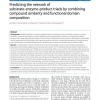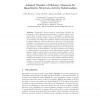235 search results - page 13 / 47 » On Similarity Measures for Spike Trains |
CIA
1999
Springer
13 years 11 months ago
1999
Springer
Abstract. Evaluations of distances or similarity measurements are very important in cooperative problem solving with multiple agents. Distance between problems is used by agents to...
UAI
2003
13 years 8 months ago
2003
Recently, spectral clustering (a.k.a. normalized graph cut) techniques have become popular for their potential ability at finding irregularlyshaped clusters in data. The input to...
BIBM
2008
IEEE
14 years 1 months ago
2008
IEEE
Identifying functionally important sites from biological sequences, formulated as a biological sequence labeling problem, has broad applications ranging from rational drug design ...
BMCBI
2010
13 years 7 months ago
2010
Background: Metabolic pathway is a highly regulated network consisting of many metabolic reactions involving substrates, enzymes, and products, where substrates can be transformed...
DIS
2010
Springer
13 years 6 months ago
2010
Springer
Quantitative structure-activity relationships (QSARs) are regression models relating chemical structure to biological activity. Such models allow to make predictions for toxicologi...


